With a better understanding of lead attribution, it will become easier to track which of your marketing sources, keywords and ads are having the most significant impact on your bottom line metrics.
The ability to attribute revenue to marketing leads is no longer a “nice to have” option, especially for companies making bigger and riskier investments in advertising.
Without lead attribution, marketers lack clear insight into what’s working, and as a consequence, waste time and money on campaigns that fail to generate any value.
Most marketers know that they need to connect their marketing leads with later stage funnel metrics, but putting together an effective lead attribution strategy is anything but easy.
As a provider of multi-touch marketing attribution, we decided to reach out to our network and asked 22 experts for their thoughts on lead attribution, plus tips on how to attribute revenue back to marketing leads.
So, for this article, we’ll discuss:
💡 Pro Tip
Ruler makes the process of lead attribution much easier. It tracks data on a visitor level, allowing you to successfully attribute leads and marketing-generated revenue across multiple campaigns, ads, keywords and more.
Track where your leads came from with Ruler
Lead attribution, or marketing attribution, is the method of assessing marketing channel success by analysing and allocating credit to each touchpoint that results in a conversion or sale.
Related: What is marketing attribution and how to get started
For example, let’s say you’re on the marketing team for a software company that provides multi-touch attribution and uses last-click attribution reporting in Google Analytics.
A user types “marketing attribution software” into Google, clicks on an ad and converts into a lead by booking a demo. In that circumstance, you’d attribute 100% of the credit to Google Ads for the conversion.
Due to its popularity, there’s been an explosion of attribution models designed to help companies track and allocate marketing-generated revenue back to leads.
Related: What is attribution modelling and how to get started
Attribution models are frameworks that track how your website visitors and customers engage with your marketing channels before converting into a lead or sale.
“There are different models that can be used to attribute capital. These models consist of logical algorithms and are complex to understand. However, they are easy to use once you find the right one for your business,” says Caroline Lee, Marketing Director at CocoSign.
Attribution models can either be single or multi-touch.
With single-touch attribution models, 100% of the credit for a lead is allocated to a single touchpoint.
Multi-touch attribution, however, allows marketers to analyse the entire conversion path with more clarity by assigning credit to more than one touchpoint.
“Multi-touch attribution is where the credit is divided up between interactions. For example, 60% is credited to the email signup, and 40% to the Facebook ad. Though this is the most complicated way to track attribution, it’s often the most accurate,” added Cierra Loflin, CMO at Zodiac Guides.
Before we get into the most common marketing attribution models, it helps to refer to an example of a customer journey, as shown below.

1. An anonymous visitor clicks on a Google ad and downloads an ebook from your website.
2. The lead goes through an email cadence, clicks a link and returns to your site to learn more about your services.
3. Two weeks later, they visit your website using a brand search via Google organic.
4. Shortly after they click on a retargeting ad on Facebook and convert by scheduling a meeting with your sales team.
In this model type, 100% of the credit for a conversion is attributed to the very first channel that the buyer interacted with.
Related: What is first-click attribution? A complete guide
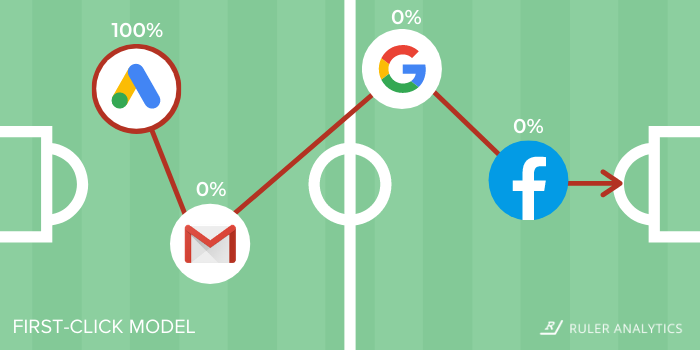
Referring to our example, the first-click attribution model has assigned all the credit to Google Ads.
“Last touch attribution is when the lead is matched based on the action right before the conversion action or purchase. For instance, the lead clicked on a digital ad right before making a purchase,” added Cierra.
Related: Marketers complete guide to last-click attribution

Going back to our example, the last-click model has assigned all the credit to the retargeting ad on Facebook.
To explain this attribution model, we’ll need to change our customer journey slightly.
Last non-direct click attribution works the same as the last-click model but with one small exception.
Direct is ignored, and 100% of the credit is assigned to the last marketing channel that a user engaged with before converting into a lead.
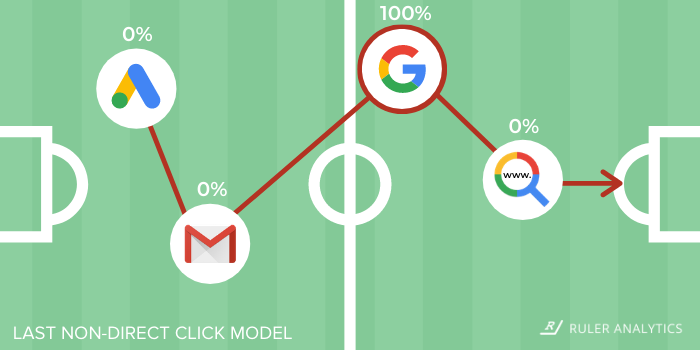
So, if we refer to our customer journey, the last non-direct click model has assigned all of the credit to the organic visit and ignored the direct touchpoint.
The linear attribution model divides the credit for a conversion equally across the entire customer journey.

If we take a look at our example, we can see that the linear attribution model has divided the credit equally across each touchpoint.
The credit for the conversion is distributed to all marketing touchpoints, but the most recent touchpoints receive a higher percentage of credit.
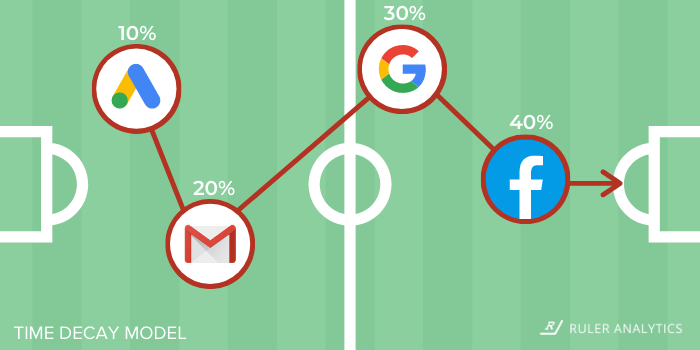
In the example above, the time decay model has allocated credit to all of the touchpoints. However, the touchpoints nearer the conversion receive more credit.
The first and last touchpoints both receive 40% of the credit for a conversion and the remaining 20% is spread evenly across any touchpoints in the middle of the journey.
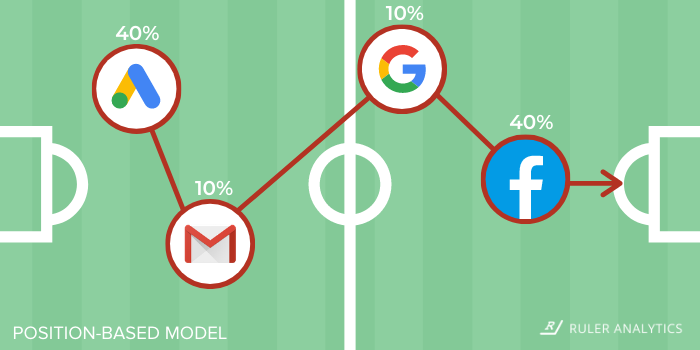
If we refer to our example, you can see that the position-based model has allocated 40% credit to Google Ads and Facebook. The remaining touchpoints share the remaining 20% credit.
The full path model is the most technical multi-touch attribution model as it tracks every marketing effort that a person experiences, including the initial touchpoint and the interaction that helped close the deal/sale.
“We usually use a full-path model. It gives 22.5% credit to the first interaction, 22.5% to the interaction that created the contact, 22.5% to the last interaction that created the deal, and 22.5% to the interaction that closed the deal. The remaining 10% gets distributed evenly across all other interactions,” says Todd Ramlin, Manager at Cable Compare.
“It accounts for every interaction a contact has with us up to the moment they become a customer,” Todd added.
💡 Pro Tip
Wondering which attribution model is best for your business? Get more information on marketing attribution and gain tips on how to choose the best model for your reporting.
Download your complete guide to marketing attribution
“When organisations effectively deploy marketing attribution, this enables additional activities such as stronger budgeting capabilities and provides sales teams with insights into expected results,” says Eric Sleeth, Sr. Marketing Manager at Veriday.
Lead attribution is a must-have for many marketers, but without the right strategy and tools, it can take some time to get up and running.
To help, we’ve extracted everything we learned from our respondents into seven fundamental tactics to bridge the gap between leads and revenue more efficiently.
“It’s always a good idea to take on a revenue marketing approach. You can analyse data and results from campaigns based on revenue, rather than basing it solely on lead generation and interactions, says Peter Home, Content Lead at Geoff McDonald and Associates.
Related: How to connect leads and sales data with revenue marketing
First and foremost, if you’re using leads to measure the performance of your marketing, then you must reevaluate your strategy.
For a long time, goals and key performance indicators have revolved around lead generation efforts, with monthly goals set to hit a target number of MQLs in order to move the needle.
More leads = more revenue, right?
Wrong.
“When it comes to leads and revenue, not every lead is going to convert to a revenue-generating conversion,” says Stephanie Riel, Founder and Owner at RielDeal Marketing.
According to research by Forrester, less than 1% of leads in B2B ever become customers.
So, if your marketing team is optimising performance based on form completions and call conversions, there’s a chance you’re wasting up to 99% of your time and money on people who will never convert into a deal or sale.
Generating a wealth of leads is great, but if they’re not converting into opportunities or moving the needle on revenue, then what’s the point? In reality, your company executives (or clients) don’t care about how many leads your latest campaign produced. They want answers to questions such as:
So, before you commence with lead attribution, you must first drive your focus away from lead generation goals such as MQLs, form completions, website traffic and concentrate on what matters most: revenue.
Kate Gross, Marketing Manager at FixThePhoto agrees that “one of the easiest ways to match marketing leads with revenue is to set your goals for revenue generation.”

“Once you’ve done this, you can look into which strategies that provide the best results in terms of marketing leads and conversions. You can convert the easiest leads in order to meet your revenue target,” Kate added.
“For our clients who are looking to prove ROI and revenue from leads, we work with businesses to put together a customer journey map that details their touchpoints to the brand. By having this sales process mapped out, we can easily align marketing to support each step of the way,” says Stephanie Riel.
Related: The ultimate guide to customer journey mapping for marketers
A customer journey map is a visual representation of the steps customers go through including, first exposure all the way through to purchase, loyalty and retention.
Mapping the customer journey allows marketing, sales and customer support teams to ensure that potential customers aren’t slipping through the cracks and is the first step towards lead and revenue alignment.

“If you have a growing business, you can no longer afford to ignore the misalignment between marketing leads and revenue. Even the purchasing process has changed. What worked for the sales team is no longer effective. Disjointed marketing leads and revenue isn’t beneficial and can be resource wasting. To match your marketing leads with revenue within your organisation, you need to create a single customer journey,” says Harriet Chan, Marketing Director at CocoFinder.
💡 Pro Tip
There are many analytics tools out there that can help with your customer journey mapping, and we wrote a blog about it.
11 customer journey analytics tool and software to consider
Harriet added, “start with the awareness stage at the top of the customer journey’s funnel, right down through to the brand loyalty stage. Everything should be tied together as an experience to allow you to track a prospect across the entire funnel. Getting everyone on the same page can be more effective as marketing and sales agree on customer profiles.”
Previously the CRM was considered a tool used solely by the sales team.
But in recent times, it’s become an essential part of the marketers’ everyday life, by providing teams with a better understanding of return on investment.
Related: What is the role of a CRM in marketing
Maximilian zur Muehlen, Business Strategy at Vem Tooling, told us that as soon as a lead comes in, they create it within their CRM software.
“We know where the lead comes from and to which marketing channel. Along the journey, this lead hopefully becomes an opportunity and leads to a sale. The revenue from that closed opportunity can directly be attributed to the lead. This provides us with a healthy amount of data to evaluate our marketing strategies,” says Maximilian.
Using marketing activity data, combined with engagement and conversion data, a CRM makes it possible for marketers to gain a better understanding of:
Brandon Spears at Double X Digital told us that they, “look at the closed deals in the CRM and see where these leads came from.”

“We add closed deals from each marketing channel to a Google Sheet that automatically creates a graph, allowing us to visually see how much we are spending and how many closes we are generating from each marketing channel,” Brandon added.
To successfully track marketing leads in the CRM and enhance data with marketing variables across multiple touchpoints such as first/last click marketing source, landing page, you must first…
Marketing attribution tracking software allows you to break the barrier between marketing and sales by providing intelligence into how, where and when your marketing efforts influenced a lead.
Andrew Maff, Founder & CEO at BlueTuskr, agrees that “the easiest way we attribute revenue to a direct marketing strategy is typically by using attribution tracking.”

There are many options to choose from, in fact, we put together a list of the best marketing attribution tools and software for 2021. However, for us, we opt for our own attribution tracking services at Ruler Analytics.
Put simply, Ruler is a visitor level multi-touch marketing attribution solution for forms, phone calls and live chat, evidencing every step a visitor makes in their journey and matching revenue back to the source.
Related: How to view full customer journeys with Ruler
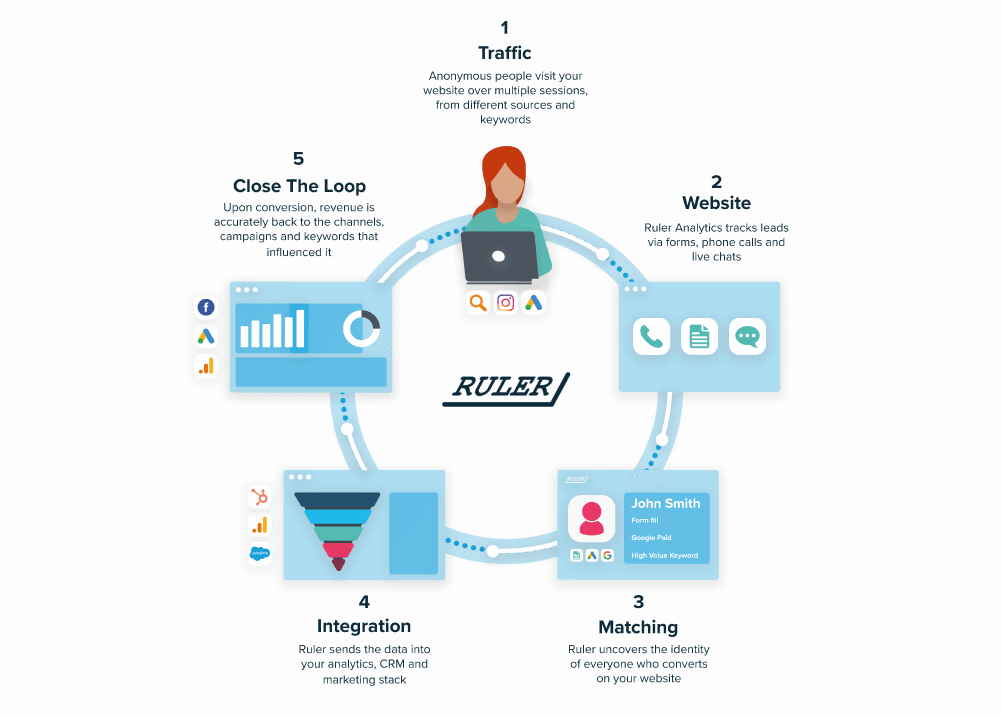
Related: How does ruler attribute revenue to your marketing
Ruler can also retrieve data from your opportunity or won/closed deals and feed the data into your other marketing platforms such as Google Ads and Analytics, Facebook, Microsoft Ads and more, allowing you to report on revenue activity from the tools you love and use every day.
💡 Pro Tip
Want to learn more us? Download the guide on how Ruler works and connects the dots between your marketing and sales. Or, alternatively, book a demo to see first-hand how Ruler can attribute marketing-generated revenue back to your leads.
For Shriya Garg, CEO at Content Ninja told us that they, “use Hubspot to generate multi-touch attribution reports to measure the impact of marketing efforts more tangibly.”
Related: Ruler vs HubSpot: Comparison and analysis
“The contact creation attribution report shows all the interactions a prospect has made with our marketing efforts up till the point the lead was recorded in the CRM. This helps us identify which blog posts, landing posts, social media posts are best at generating new leads. The best part is that Hubspot’s attribution model lets us apply a different weight to each interaction,” Shriya added.
Alternatively, Martina Cooper, reviewer at BHMR, recommends Hyros, as it gives an in-depth and hyper-accurate tracking system for digital marketing.
“Hyros track every single action and all your visitors’ behaviour within one app. There is some other free software like Magic, but I think Hyros is way better for most businesses to help attribute revenue to particular leads,” added Martina.
“My best advice for attributing revenue to marketing leads is to invest in a reliable revenue management software,” says Stephen Light, Chief Marketing Officer and Co-Owner at Nolah Mattress.

“Revenue management software contains a robust array of information that helps decision-makers maximise revenue by pinpointing marketing campaigns that yielded the most sales,” Stephen added.
At Ruler, we use our platform and revenue management system, ChartMogul, to track and report on revenue driven by our marketing activities.
In ChartMogul, we’ve set up custom attributes and marketing source data is passed from our attribution solution so that we can see more than which campaigns bring the most leads.
ChartMogul also connects directly with our payment processor.
So, every month, the revenue we are generating from each customer gets attributed back to all of the data we have, allowing us to track and report on subsequent sales.
Related: How Ruler uses ChartMogul to close the loop between marketing and revenue

Coincidently, Shiv Gupta, CEO at Incrementors Web Solution, explained that they also use a similar process involving ChartMogul.
“When a lead turns into revenue, we integrate the customer’s detail, such as the revenue amount and marketing data, into a database. This data is then synced with our subscription and revenue system, Chartmogul.”
“Inside Chartmogul, we’ve set up custom attributes to obtain the marketing data. It also joins directly with our payment processor. So, every month the revenue we’ve generated from each consumer gets attributed back to its initial touchpoints. Letting me track and report on any subsequent sales,” Shiv explained.
If you haven’t got the budget to spend on marketing attribution tools, then Google Analytics is a free alternative that can help track marketing’s impact on company growth objectives.
Related: How to track your marketing revenue in Google Analytics
“Google Analytics is the best place to start and get acquainted. It helps to know where your lead came from, such as the source, time and date, search phrase used,” says Sam Carter, Sales Manager at Challenge Coins 4 U.
While Google Analytics isn’t a complete solution to attribute revenue back to your marketing leads, it does have a wealth of powerful features that allows you to figure out whether your campaigns are helping your company’s bottom line.
“If everything is set up correctly, you should be able to see a breakdown of each marketing channel and how much revenue they have each generated in a specified timeline,” says Michael Anderson, Marketing Specialist at Signal Power.
“The acquisition tab allows marketers to see exactly where their revenue is coming from and can help identify the most profitable marketing channels. The only caveat to this is that leads can become assigned to direct, which essentially means that Google isn’t sure how they found your website. This can happen if someone enters a URL directly into their browser or clicks on a link that can’t be traced back to a specific source for one reason or another,” Michael added.
💡 Pro Tip
By integrating Ruler and Google Analytics, you can effortlessly match leads and revenue to their most profitable online sources using different attribution models. Learn how Ruler can improve your Google Analytics reports.
How Ruler enriches your attribution reports in Google Analytics
Asking customers how they discovered your products and services allows you to identify your most effective communication channels and optimise marketing performance based on actual customer feedback.
“If you have multiple marketing channels, it can be difficult to know where exactly your investment is paying off and where it’s falling short. The most effective solution is to ask your customers to fill out a survey detailing their experience with your company after making a purchase,” says Mark Hayes, Head of Marketing at Kintell.

“Make sure that you ask your customer how they found your company initially because this is going to provide you with valuable, actionable insights. If the overwhelming majority of respondents came from the same place, for example, you know where to re-allocate your marketing budget to capture more leads and convert more prospects to customers.”
💡 Pro Tip
While asking people to fill out a survey can provide some basic insights, is it enough on its own to accurately attribute where your leads are coming from? We put it to the test. Find out our results below.
Why asking how leads found you isn’t enough
Here are key takeaways that you can start implementing today.
Simple lead generation is not enough.
First and foremost, quit relying on metrics such as conversions, MQLs, and form fills that don’t move the needle.
Company executives don’t care about how many leads you have.
They care about how many leads convert into sales.
Once you start focusing on revenue-focused metrics and goals, it’ll become easier to communicate marketing’s impact on bottom-line objectives.
“To calculate the overall quality of the leads, you need to look at the percentage of MQLs that turn into actual new customers. Consider this example, Company A generates 100 leads per month but only converts three of them into new customers, while Company B generates 50 leads per month but converts 20 into new customers. On paper, Company A appears to be doing a better job, but the numbers show that Company B is producing much more qualified leads,” says Daniel Velez Vasquez, CEO at Home Security.
Lead attribution works best when every step of the customer journey is taken into consideration.
Customer journey analytics helps marketing, sales and customer support teams map every touchpoint that a user engages with across multiple channels and campaigns before converting into a sale—and beyond.
“It is important to track the touchpoints between the first and last interaction. This will enable an understanding of touchpoint effectiveness based on type and frequency,” says Eric Sleeth.
The CRM is essential for lead tracking, allowing companies to track and record vital information more efficiently.
When used in tandem with other tools, marketers can optimise channels and campaigns to generate more qualified leads and sales.
“The very first step towards accurate attribution is to invest in the correct tools.
The right tools will give you access to real-time information and help you set up all sorts of tracking and monitoring, which can help you build your case.
Tools like Google Analytics are great at providing high-end figures,” says Ethan Taub, CEO at Goalry.
The right marketing attribution tools can unlock powerful data across the entire sales cycle, and more importantly, evidence which marketing activities drive the most qualified leads.
“By establishing the value of each lead and conversion, and regularly reviewing your analytics, you will learn what works best for your unique goals, business and industry, and be able to identify your ROI for every marketing dollar you spend”, says Jessica Mason, Digital Marketing Strategist at Jessica Mason Marketing.
”When you are looking to attribute revenue to your marketing leads you have to measure the success of each marketing scheme or situation, so that then you have the data to be able to show what money is coming from where”, says Mike James, Sales Manager at Coffeeble.
Marketers who are responsible for spending money to generate leads should have a solution in place to see if their campaigns are generating actual value.
When you understand the different attribution models and have a solution that can help capture and filter your marketing source data, you can go on to improve your campaigns, reduce waste, and drive more qualified leads for your company.
“If you have a lot of success with one project and not with another, you can show the revenue coming from the more popular source down to factors such as views, clicks, purchases etc.
All of these can be attributed to any new marketing projects you start, and can be a great way to measure success, and therefore measure revenue streams and where they start,” says Mike.
Want to learn more about lead attribution? Book a call with one of our sales representatives and start focusing on the revenue impact of your marketing activities.
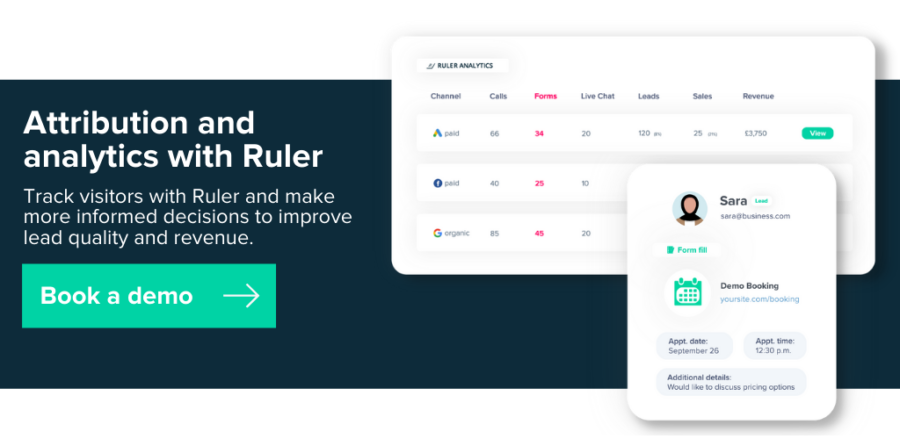
This article was originally published in April 2021 and was last updated on 26th April for freshness.